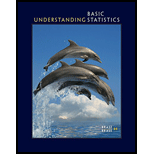
Concept explainers
Business: Customers John runs a computer software store. Yesterday hecounted 127 people who walked by his store, 58 of whom came into the store.Of the 58, only 25 bought something in the store.
(a) Estimate the
(b) Estimate the probability that a person who walks into the store will buy something.
(c) Estimate the probability that a person who walks by the store will come in and buy something.
(d) Estimate the probability that a person who comes into the store will buy nothing.
(a)
To find: The estimated probability that a person, who walks by the store, will enter the store.
Answer to Problem 23P
Solution: The estimated probability is 0.46.
Explanation of Solution
Given: 127 people walked by the store, 58 of them entered the store. Out of 58, 25 of them bought something.
Calculation:
The provided values can be tabulated as follows:
The formula that is used to assign probability is:
Substitute the provided values in the above formula to find the desired value of probability.
The required probability can be calculated as follows:
The required probability is 0.46.
Interpretation: There is a 46% chance that a person, who walks by the store, will enter the store.
(b)
To find: The estimated probability
Answer to Problem 23P
Solution: The estimated probability is 0.43.
Explanation of Solution
Given: 127 people walked by the store, 58 of them came into the store. Out of 58, 25 of them bought something.
Calculation:
The provided values can be tabulated as follows:
The formula that is used to assign probability is:
Substitute the provided values in the above formula to find the desired value of probability.
The required probability can be calculated as follows:
The required probability is 0.43.
Interpretation: There is a 43% chance that a person, who walks into the store, will buy something.
(c)
To find: The estimated probability
Answer to Problem 23P
Solution: The estimated probability value is 0.20.
Explanation of Solution
Given: Consider the calculated probabilities from part (a) and (b). The values are:
Calculation: Consider any two independent events A and B. The formula to calculate the probability that two independent events will occur together is given as,
Here, entering the store and buying something after entering are independent events.
So, the required probability can be calculated as follows:
The required probability is 0.20.
Interpretation: There is a 20% chance that a person who walks by the store will come in and buy something from the store.
(d)
To find: The estimated probability
Answer to Problem 23P
Solution: The estimated probability is 0.57.
Explanation of Solution
Given: 127 people walked by the store, 58 of them came into the store. Out of 58, 25 of them bought something.
Calculation:
The provided values can be tabulated as follows:
The formula that is used to assign probability is:
Substitute the provided values in the above formula to find the desired value of probability.
The required probability can be calculated as follows:
The required probability is 0.57.
Interpretation: There is a 57% chance that a person who comes into the store will buy nothing.
Want to see more full solutions like this?
Chapter 5 Solutions
Understanding Basic Statistics
- A company found that the daily sales revenue of its flagship product follows a normal distribution with a mean of $4500 and a standard deviation of $450. The company defines a "high-sales day" that is, any day with sales exceeding $4800. please provide a step by step on how to get the answers in excel Q: What percentage of days can the company expect to have "high-sales days" or sales greater than $4800? Q: What is the sales revenue threshold for the bottom 10% of days? (please note that 10% refers to the probability/area under bell curve towards the lower tail of bell curve) Provide answers in the yellow cellsarrow_forwardFind the critical value for a left-tailed test using the F distribution with a 0.025, degrees of freedom in the numerator=12, and degrees of freedom in the denominator = 50. A portion of the table of critical values of the F-distribution is provided. Click the icon to view the partial table of critical values of the F-distribution. What is the critical value? (Round to two decimal places as needed.)arrow_forwardA retail store manager claims that the average daily sales of the store are $1,500. You aim to test whether the actual average daily sales differ significantly from this claimed value. You can provide your answer by inserting a text box and the answer must include: Null hypothesis, Alternative hypothesis, Show answer (output table/summary table), and Conclusion based on the P value. Showing the calculation is a must. If calculation is missing,so please provide a step by step on the answers Numerical answers in the yellow cellsarrow_forward
 College Algebra (MindTap Course List)AlgebraISBN:9781305652231Author:R. David Gustafson, Jeff HughesPublisher:Cengage Learning
College Algebra (MindTap Course List)AlgebraISBN:9781305652231Author:R. David Gustafson, Jeff HughesPublisher:Cengage Learning Holt Mcdougal Larson Pre-algebra: Student Edition...AlgebraISBN:9780547587776Author:HOLT MCDOUGALPublisher:HOLT MCDOUGAL
Holt Mcdougal Larson Pre-algebra: Student Edition...AlgebraISBN:9780547587776Author:HOLT MCDOUGALPublisher:HOLT MCDOUGAL


